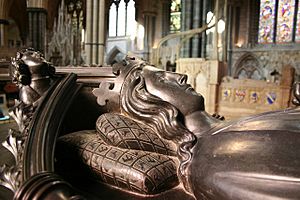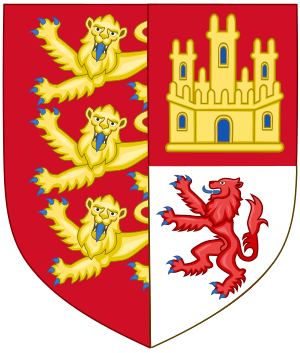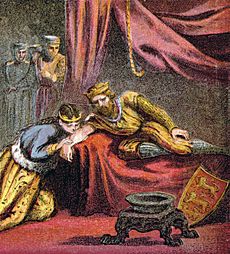Eleanor of Castile facts for kids
Quick facts for kids Eleanor of Castile |
|
|---|---|

Tomb Effigy of Eleanor at Lincoln Cathedral
|
|
| Queen consort of England | |
| Tenure | 20 November 1272 – 28 November 1290 |
| Coronation | 19 August 1274 |
| Countess of Ponthieu | |
| Reign | 16 March 1279 – 28 November 1290 |
| Predecessor | Joan |
| Successor | Edward II |
| Alongside | Edward I |
| Born | 1241 Burgos, Castile, Spain |
| Died | 28 November 1290 (aged 48–49) Harby, Nottinghamshire, England |
| Burial | 17 December 1290 Westminster Abbey, London; Lincoln Cathedral, Lincs. |
| Spouse | |
| Issue among others |
|
| House | Castilian House of Ivrea |
| Father | Ferdinand III of Castile |
| Mother | Joan, Countess of Ponthieu |
| Religion | Roman Catholicism |
Eleanor of Castile (born 1241 – died 28 November 1290) was the first wife of Edward I. She became Queen of England when she married Edward. Their marriage was part of a political agreement to make sure England controlled Gascony, a region in France.
Eleanor and Edward were very close. She often traveled with him, even joining him on the Ninth Crusade. During this crusade, Edward was hurt, and a popular story says Eleanor saved him by sucking poison from his wound. However, this story is not true. When Eleanor died near Lincoln, Edward was heartbroken. He ordered special stone crosses to be built at every place her funeral procession stopped on its way to London. The last cross was at Charing Cross.
Eleanor was more educated than most queens of her time. She had a big influence on English culture. She loved books and art, and she brought new styles of tapestries, carpets, and garden designs from Spain. She was also a smart businesswoman. She had her own wealth as the Countess of Ponthieu, which was her mother's land.
Life Story of Queen Eleanor
Her Birth and Early Life
Eleanor was born in Burgos, Spain, around 1241. Her parents were Ferdinand III of Castile and Joan, Countess of Ponthieu. Her Spanish name was Leonor, which became Eleanor in English. She was named after her great-grandmother, Eleanor of England.
Eleanor was the second of five children. Her parents and half-brother, Alfonso X of Castile, loved books and learning. This means Eleanor likely received a better education than most girls back then. She was with her father when he died in Seville in 1252.
Marriage to Edward I
Eleanor's marriage to Edward in 1254 was very important. It helped settle a disagreement between England and Castile over the region of Gascony in France. Edward's father, Henry III of England, wanted the marriage to happen quickly.
Eleanor and Edward were married on November 1, 1254, in Burgos. They were distant cousins. After their wedding, they spent almost a year in Gascony. Eleanor, who was only about 13, likely had her first child there, a daughter who did not live long. Eleanor then traveled to England alone in 1255, and Edward followed her a few months later.
At first, some English people were not happy about the marriage. They worried that Eleanor's Spanish relatives would come to England and rely on the king's money. A few of her relatives did come, and Eleanor was blamed, even though she was too young to stop it.
Supporting Edward in War
Not much is known about Eleanor's life in England until the 1260s. This was when the Second Barons' War began, a fight between King Henry III and his powerful barons. Eleanor strongly supported Edward during this time. She even brought archers from her mother's land in France to help him.
Eleanor stayed in England throughout the war. She held Windsor Castle and kept prisoners for Edward. After Edward's army won the Battle of Evesham in 1265, Eleanor became more important. Her position improved even more when she gave birth to sons, John and Henry, and a healthy daughter, Eleanor. These children were important for the future of the royal family.
Journey to the Holy Land
By 1270, England was peaceful again. Edward and Eleanor decided to join a crusade to the Holy Land. They traveled to Acre in May 1271. While there, Eleanor gave birth to another daughter, who was named Joan of Acre after her birthplace.
The crusade did not achieve its military goals. In June 1272, someone tried to assassinate Edward. He was wounded in the arm, and the wound became very bad. A surgeon saved him by cutting away the infected flesh.
Edward and Eleanor left Acre in September 1272. In December, they learned that Edward's father, King Henry III, had died. After visiting Gascony, where their son Alphonso was born, they returned to England. They were crowned together on August 19, 1274.
Queen of England
Many royal marriages in the Middle Ages were not happy, but Eleanor and Edward truly loved each other. They were rarely apart. Eleanor even went with Edward on his military trips to Wales. Their son Edward was born at Caernarfon Castle during one of these trips in 1284.
Their household records show they had a fun relationship. Every Easter Monday, Eleanor's ladies would pretend to trap Edward in his bed. He would pay them a small "ransom" to go to Eleanor's room. This custom was so important to him that even after Eleanor died, he still paid her ladies on Easter Monday. Edward also disliked formal events. Once, Eleanor paid musicians to play for him while he sat alone during a wedding he did not want to attend.
Edward did not marry again until 1299, nine years after Eleanor's death. This shows how much he missed her. In a letter from 1291, he wrote that he "dearly cherished" her when she was alive and "cannot cease to love" her after her death. To honor her, Edward ordered twelve beautiful stone crosses to be built. These crosses marked the places where her funeral procession stopped between Lincoln and London. Today, only three of these "Eleanor crosses" still stand, and none are complete.
Only one of Eleanor's four sons lived to be an adult. Even before she died, Edward worried about who would become king next. If their last son died, their daughters' husbands might fight for the throne. So, Edward decided to marry again to have more sons. He was happy with the sons his new wife had, but he continued to attend memorial services for Eleanor for the rest of his life.
Eleanor's Popularity
Today, Eleanor is remembered for the beautiful crosses Edward built for her. However, she was not always popular during her lifetime. People mostly knew her as a very keen businesswoman. One poem from her time said:
The king would like to get our gold,
the queen, our manors fair, to hold ...
Another writer noted that she "acquired many fine manors" (large estates).
Eleanor's land dealings were unusual for a queen. She bought many estates, which made her very wealthy. Edward actually helped her do this. He wanted her to have enough money without using funds needed for the government. One way she got land was by taking over debts that Christian landowners owed to Jewish moneylenders. In return for canceling the debts, she received the lands that were promised as payment. Often, the landowners were happy to be free of the debt. Eleanor also showed them favor afterward, sometimes letting them use the lands for life.
However, Eleanor's property dealings made her unpopular. People complained that her officials were too harsh with her tenants. On her deathbed, Eleanor asked Edward to appoint judges to look into her officials' actions and make things right. Records show that her officials often acted unfairly without Eleanor knowing. When Eleanor heard about such wrongs, she would correct them. Her request to Edward shows she suspected her officials had done more wrong than she knew.
Some people also thought Eleanor encouraged Edward to rule strictly. They believed she could be a severe woman if someone crossed her. This was different from what people expected of queens, who were supposed to help those in need.
So, it seems Eleanor was not widely loved outside her close friends and family. It was only after her death that writers began to say good things about her. The impressive "Eleanor Crosses" Edward built also helped improve her image.
Eleanor's Influence
For a long time, people thought Eleanor had little political power. They believed her role was small, except for advising Edward on when their daughters could marry foreign rulers. However, newer research suggests Eleanor might have played a role in Edward's decisions. She sometimes helped settle disagreements between nobles in England and France.
Some of Edward's laws and military plans seemed to be influenced by ideas from Castile, Eleanor's home country. She even suggested Edward read a book about military strategies. But Edward was also willing to stop her if he felt she was going too far. His ministers would also step in if her actions caused problems for important people.
Cultural Impact
Eleanor was a very smart and cultured woman. She found other ways to use her energy. She loved books and supported writers. She had her own workshop with scribes and artists to copy books for her. These books included stories and lives of saints. Her interests were wide and sophisticated. She had a book about military tactics translated for Edward. She also commissioned stories about her family history and other tales. She exchanged books with her half-brother, Alfonso X of Castile.
Eleanor probably spoke French, her mother's language, better than English. The English court at the time was still largely bilingual, meaning people spoke both French and English. When people asked her for help, sometimes a courtier had to translate for her. All the books she commissioned and most of her letters were in French.
In her home life, Eleanor made tapestries and carpets popular. When she first arrived in London, these were seen as a Spanish luxury. But by the time she died, many wealthy people in England used them. She also brought in the use of fine tableware, decorated knives, and even forks. She also had a big impact on garden design in royal estates. She spent a lot on gardens, including water features, which were common in Spanish gardens.
Eleanor was a strong supporter of the Dominican Order of friars. She founded several priories (religious houses) in England and supported their work at the universities of Oxford and Cambridge. She was very religious, but she preferred to have her chaplains (religious assistants) give money to the poor for her. She gave a lot to charity.
She also helped many of her relatives. Because foreigners were not very popular in England, she was careful about which cousins to support. Instead of marrying her male cousins to wealthy English women, she arranged marriages for her female cousins to English barons. Edward supported her in this. These marriages created a network of supporters for the royal family. These marriages also helped Edward maintain good relationships with other countries.
Her Death
Eleanor seemed healthy for most of her life. She had at least sixteen pregnancies, which shows she was strong. However, after her last child was born, records show she often needed medicines. Later, in 1287, while in France with Edward, a letter said she had a "double quartan fever." This suggests she had a type of malaria, which can make people weak and sick.
As time went on, Eleanor seemed to know she did not have long to live. Plans for her daughters' marriages were sped up. In the summer of 1290, she began a slow tour of her properties in the north. The autumn Parliament was held closer to her, in Clipstone. Her children were called to visit her, even though travel might have been risky for them.
Her last stop was at the village of Harby, Nottinghamshire. She died there on the evening of November 28, 1290, at about 49 years old, after 36 years of marriage. Edward was with her and heard her final wishes. For three days after her death, the government stopped working.
Funeral and Memorials
Eleanor's body was taken in a grand procession from Lincoln to Westminster Abbey. Edward followed for most of the journey, along with many mourners. Edward ordered memorial crosses to be built at each place the procession stopped overnight. These beautiful "Eleanor crosses" showed Edward's grief and also made his kingship look strong. The crosses were built in places like Lincoln, Stamford, Geddington, and Charing. Only three survive today, and none are complete. The one at Geddington is the best preserved.
The monument known as "Charing Cross" in London today was built much later, in 1865. The original Charing cross was destroyed in 1647.
In the 1200s, it was common to bury different parts of a person's body in different places. Eleanor had a "triple" burial. Her internal organs were buried in Lincoln Cathedral. Edward placed a copy of her Westminster tomb there. Her heart was buried in a church in London called Blackfriars, along with her son Alphonso's heart. This monument was destroyed in the 1500s.
Eleanor's main funeral was at Westminster Abbey on December 17, 1290. Her body was placed in a grave near the main altar. Her tomb was probably ordered before she died. It has a marble chest with carvings and shields showing the coats of arms of England, Castile, and Ponthieu. On top is a beautiful bronze statue of Eleanor, made by William Torel.
When Edward married again ten years later, he and his new wife, Margaret of France, named their only daughter Eleanor in her honor.
Eleanor's Legacy
Eleanor of Castile's time as queen was important for English history. She helped create a stable financial system for the king's wife. The lands Eleanor gathered became the starting point for lands given to later queens of England for centuries. Her involvement in these land deals made it clear that a queen could manage her own money and properties. Few later queens were as active in business as Eleanor, but their ability to do so was thanks to the rules set during her lifetime.
Eleanor's Children
Eleanor and Edward had many children, but sadly, many did not live long. Here are some of them:
- A daughter (born and died July 1255)
- Katherine (born and died 1264)
- Joanna (born and died 1265)
- John (1266 – 1271)
- Henry (1268 – 1274)
- Eleanor (1269 – 1298). She married Count Henry III of Bar.
- A daughter (born 1271 in the Holy Land)
- Joan (1272 – 1307). She married Gilbert de Clare, 6th Earl of Hertford and later Ralph de Monthermer, 1st Baron Monthermer.
- Alphonso (1273 – 1284)
- Margaret (1275 – after 1333). She married John II of Brabant.
- Berengaria (1276 – 1278)
- A daughter (born and died 1277/1278)
- Mary (1279 – 1332). She became a Benedictine nun.
- A son (born and died 1280 or 1281)
- Elizabeth (1282 – 1316). She married John I, Count of Holland and later Humphrey de Bohun, 4th Earl of Hereford.
- Edward II of England, also known as Edward of Caernarvon (1284 – 1327). He became king and married Isabella of France.
Eleanor as a Mother
Some people have suggested that Eleanor and Edward cared more about each other than their children. However, as king and queen, they had to travel a lot. Young children could not handle constant travel. Their children had their own household with trusted caregivers. Eleanor and Edward wrote to them regularly.
When the children were older, they started to travel with their parents. Eleanor sent one of her scribes to help with their education. She also sent gifts to her children often. When she was in Wales, she moved the children's household closer to her. Edward also gave detailed instructions for the care of his children.
Two stories are sometimes used to say Eleanor was not interested in her children, but they can be explained. When their six-year-old son Henry was dying in 1274, neither parent went to see him. But Henry was with Edward's mother, Eleanor of Provence, who was very close to him. Also, Eleanor was pregnant at the time, and it might have been risky for her to be near a sick child.
Similarly, Edward and Eleanor let Eleanor's mother, Joan, Countess of Ponthieu, raise their daughter Joan of Acre in France for a few years. This was a common practice for noble children. However, when Joan returned to England at age six, she was quite spoiled. As an adult, she sometimes challenged her father, Edward. For example, she secretly married a squire (a knight's assistant) against his wishes. Edward was very angry at first, but Joan defended herself. She said that if a great earl could marry a poor woman, there was nothing wrong with a countess marrying a promising young man. Edward eventually accepted her new husband and gave back the lands he had taken from her.
Images for kids
See also
 In Spanish: Leonor de Castilla para niños
In Spanish: Leonor de Castilla para niños






